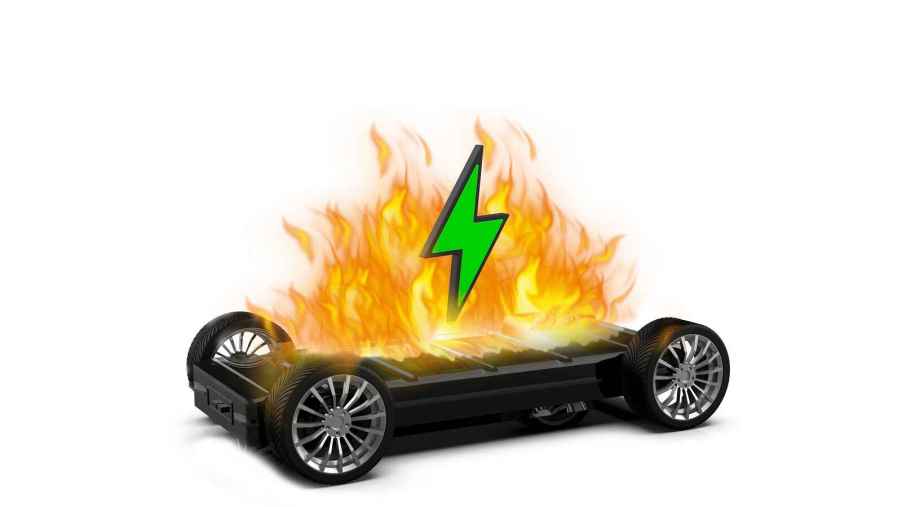
How Do EV Battery Fires Start, and What on Earth Stops Them?
Despite years of negative public perception about the frequency of EV fires, they’re statistically more rare than ICE vehicle fires. However, when they occur, they’re quite dangerous and hard to control. Here, I’ll explain what “thermal runaway” is. Then, I cover what product will likely become a common household item to handle EV fires.
Thermal runaway can happen anytime after an EV collision
Damaged lithium-ion battery cells might suddenly start to self-heat. The misbehavior is contagious between cells and boosts temps from zero to above 2,000 degrees Fahrenheit in seconds. This phenomenon, which most commonly occurs in the event of a collision, is called thermal runaway. The heat, plus toxic gases, are quickly leached out into the surrounding environment. This can result in a fire or explosion.
What’s more, if an EV has a damaged lithium-ion battery and it isn’t properly flagged or handled, the battery can sit without issue for months on end before randomly entering thermal runaway.
Marc Sebastian is a retired collision repair shop executive. He says that the longest he’s heard an EV has gone between the date of a collision and the date the defective battery went up in flames is nine months.
“The customer has received their vehicle back at that point after the repair [and] this vehicle could still catch fire if a battery was not properly looked at and properly dealt with,” he told Repairer Driven News. “The reality is that this is a real problem and it’s a scary problem.”

EV fires can occur without a collision
We’ve all heard the news stories of EVs catching fire while charging at home overnight.
Repairer Driven News shared that EV owners might lessen the chance of thermal runaway occurring and creating a high-heat fire by avoiding certain behaviors.
First, don’t let the battery charge dip below 20%. Continuously draining the battery to near zero could be linked to cell misbehavior down the line.
Second, you might avoid charging your EV overnight. This concept is really no different than any other appliance. We shouldn’t be leaving certain things plugged in longer than they need to be. Anything that could experience thermal runaway could fall into this category.
Today, lithium-ion fires are difficult or impossible to extinguish
Although rare compared to ICE fires, EV fires can perplex and frustrate first responders. Why? Because the gases and flames emitted from EV batteries are pretty much “unaddressable.”
Basically, you just have to get to safety and let the fire burn itself out.
“Being a firefighter, we came across a couple of lithium battery fires and really had no solutions,” explains Jesse Corletto, a retired firefighter. He also says that some New York firefighters have told him that they deal with EV fires daily without anything on hand to help quell the hazardous flames.
There are specialty blankets you can throw on an EV fire, but they’re expensive and dangerous to use. They require getting right up to the burn source. They also cost thousands and don’t always work well.
Several years ago, Corletto began working on a handheld EV fire extinguisher. Now, he and Sebastian are business partners. Their company, E-FireX, is prepping to launch the finished product in May 2024.
EV-spec fire extinguishers will likely become common household products
As EVs become more commonplace, products designed to handle thermal runaway will become as common.
The E-FireX extinguisher contains an “all-natural-based encapsulated agent” that will control high-heat fires, including lithium and metal-based flames.
The company hopes the product will land in every fire department, repair facility, impound lot, and personal garage handling EVs.
Other companies are working on additional products. One is a “paper” of sorts that can be wrapped around lithium-ion batteries and will serve as a sheath to encapsulate heat in case thermal runaway occurs.
Until EV fire extinguishers are commonplace, there’s not much you can do about an EV fire. If ever you find yourself near one, it’s best to just get yourself and any dependents as far away from danger as possible. Let first responders do what they can to control it once they enter the scene.
Additional source: IEEE Spectrum






